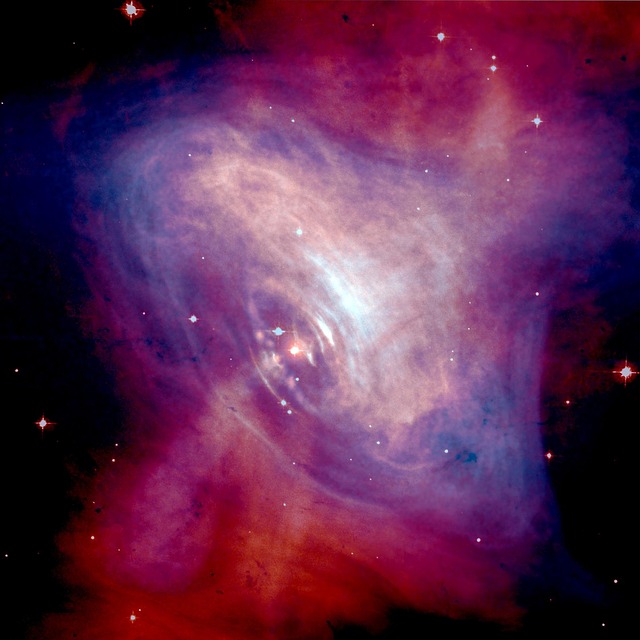
Astrophysicists from various international associations, using some of the largest radio telescopes in the world, have found evidence of waves that oscillate with periods ranging from years to decades. These results have been possible thanks to a precise observation of a set of cosmic clocks (pulsars) in our Galaxy, as detailed in a series of articles published today in The Astrophysical Journal Letters.
The gravitational wave signal has been observed through data taken by the North American Nanohertz Observatory for Gravitational Waves (NANOGrav) at the Physics Frontiers Center (PFC) for 15 years. This collaboration, of more than 190 scientists, mostly from the US and Canada, funded by the American National Science Foundation (NSF), uses pulsars (a neutron star that rotates very rapidly on its axis, emitting at each turn a radio 'pulse') to identify the presence of gravitational waves. International collaborations using telescopes in Europe, India, Australia, and China have independently shown similar results.
While previous NANOGrav results discovered a mysterious temporal signal in all pulsars that were observed, this signal was too weak to reveal its origin. Data released today from 15 years of observation demonstrate that the signal is consistent with the presence of slow-rolling gravitational waves traversing our galaxy. "This is key evidence for gravitational waves at very low frequencies," according to Dr. Stephen Taylor of Vanderbilt University, current Principal Investigator of this international collaboration. "After years of work, NANOGrav is breaking new ground in the universe of gravitational waves".
Unlike the fleeting high-frequency gravitational waves observed by ground-based instruments such as LIGO (the Laser Interferometry Gravitational wave Observatory), this continuous low-frequency signal can only be perceived with a detector much larger than Earth. To do this, astronomers turned our sector of the Milky Way into a huge gravitational wave antenna using exotic stars called pulsars. NANOGrav has obtained data from 68 pulsars over 15 years, which has allowed it to form a type of detector called a "Pulsar Timing Array".
A pulsar is the ultradense remnant of the core of a massive star after its disappearance in a supernova explosion. Pulsars spin rapidly, emitting pulses of radio waves that sweep the space around them similar to the pulses of light from a lighthouse on the coast. These stars therefore appear to "beat" when viewed from Earth. The fastest of these objects, called millisecond pulsars, spin hundreds of times every second. Their pulses are very stable, making them useful as accurate cosmic clocks.
Einstein's theory of General Relativity accurately predicts how gravitational waves should affect the signals from these pulsars. By stretching and compressing the fabric of space-time in their wake, gravitational waves affect the timing of each pulse in a slight but predictable way, slowing some of them down and bringing others forward. These offsets are correlated for all pulsar pairs according to how far apart the two stars are in the sky. The data obtained by NANOGrav are perfectly compatible with what the theory of Relativity predicts.
Comparing these theoretical predictions with the data presented today, we can ensure that the most recent NANOGrav data set shows evidence of the presence of gravitational waves with periods ranging from years to decades. These waves could arise from the most massive black holes in the entire Universe: billions of times more massive than the Sun, with sizes greater than the distance between the Earth and the Sun. Future studies of this signal will open a new path in the universe of gravitational waves, providing information about titanic black holes merging at the heart of distant galaxies, among other exotic sources.
In the words of Jose Juan Blanco-Pillado, Ikerbasque Researcher at the UPV/EHU and associate member of NANOGrav: “These results mark a milestone in the history of gravitational wave detection and allow us to observe the universe from a new perspective. In the future, we hope that these types of observations will help us understand known astrophysical processes and identify or discover other phenomena that have remained hidden until now. “
“In particular, the research that we carry out at the UPV/EHU focuses on identifying new processes in the primordial universe that can give a signal that can be detected by this type of gravitational wave observatories. The detection of this type of signals in an unequivocal way would give us very valuable information on how the universe evolved in its first moments.”
Astrophysicists around the world have been chasing this gravitational wave signal. Several papers published today by the Parkes Pulsar Timing Array Australia, Chinese Pulsar Timing Array and European Pulsar Timing Array/Indian Pulsar Timing Array collaborations show hints of the same signal in their data. Through the International Pulsar Timing Array consortium, regional collaborations are working together to combine their data to better characterize the signal and search for new types of sources convinced of the importance and need for international collaboration.
Bibliographic reference
Gabriella Agazie et al
The NANOGrav 15 yr Data Set: Evidence for a Gravitational-wave Background
The Astrophisical Journal Letters. 951:L8 (24pp), 2023 July 1
DOI: 10.3847/2041-8213/acdac6
.png)
